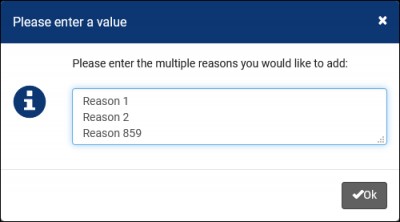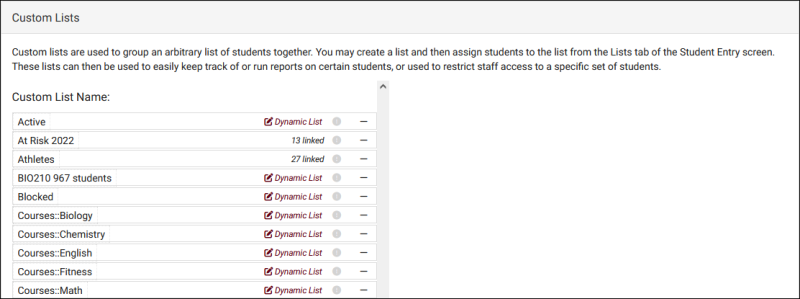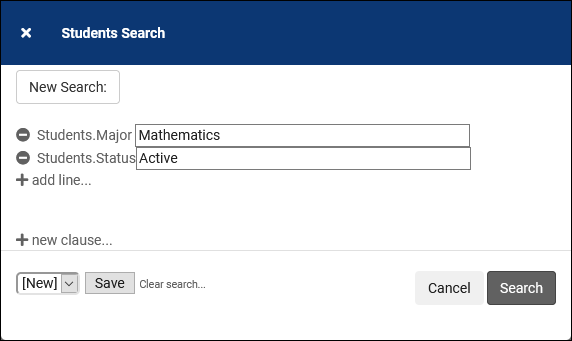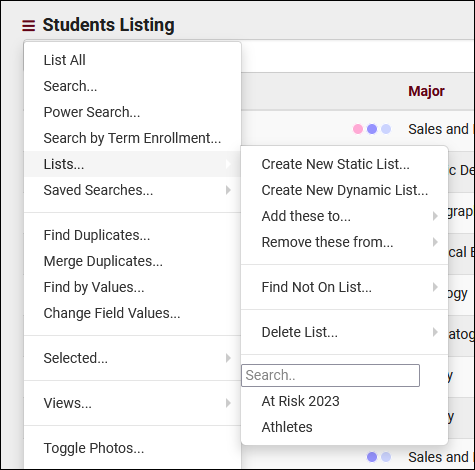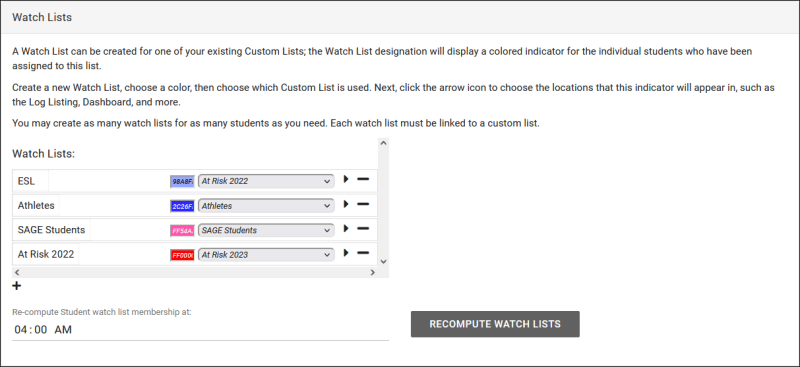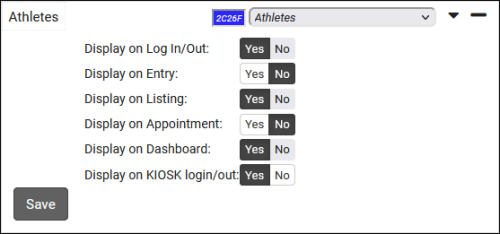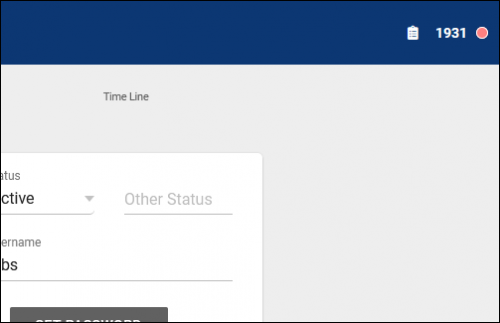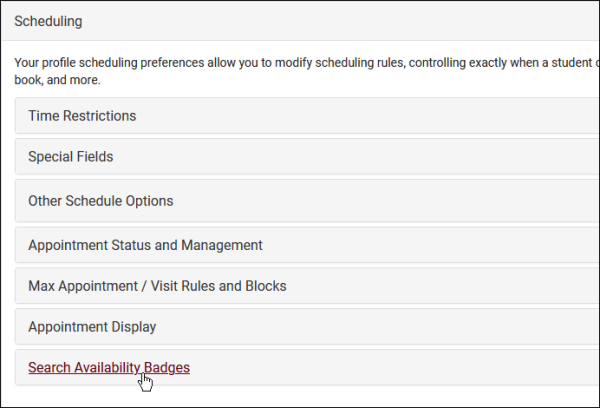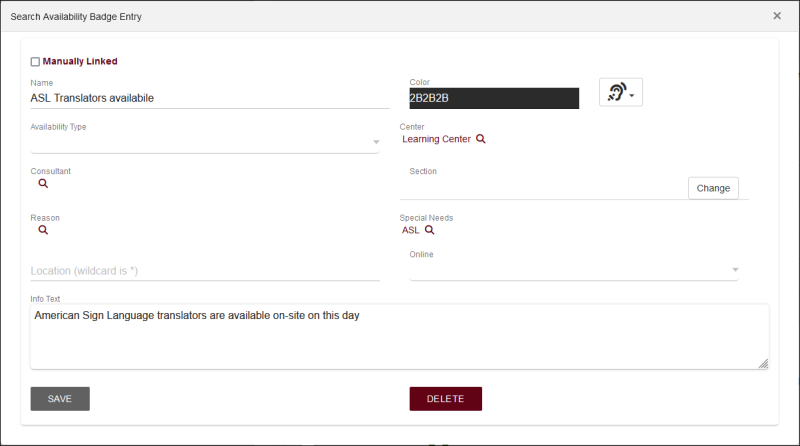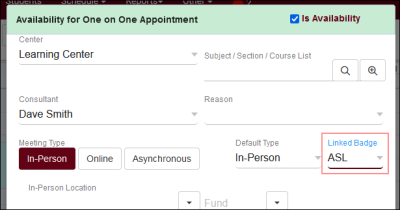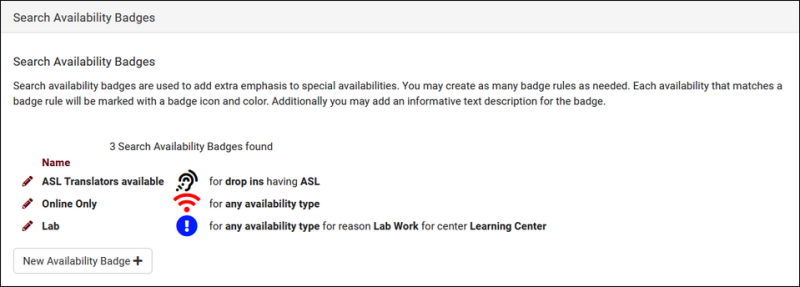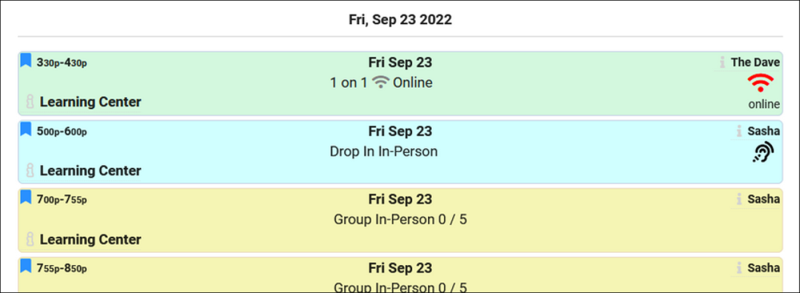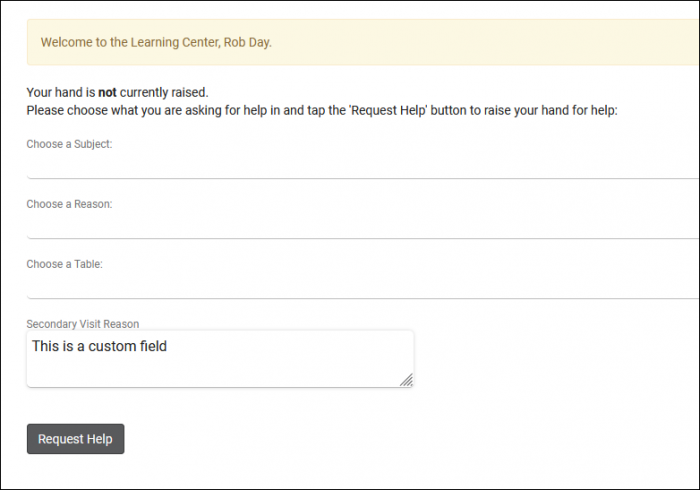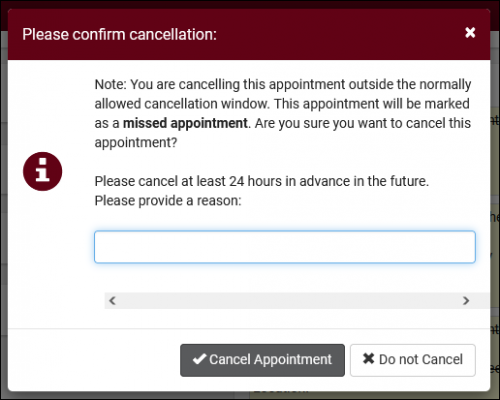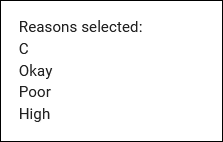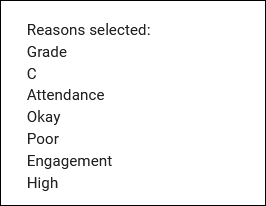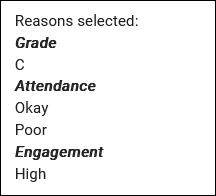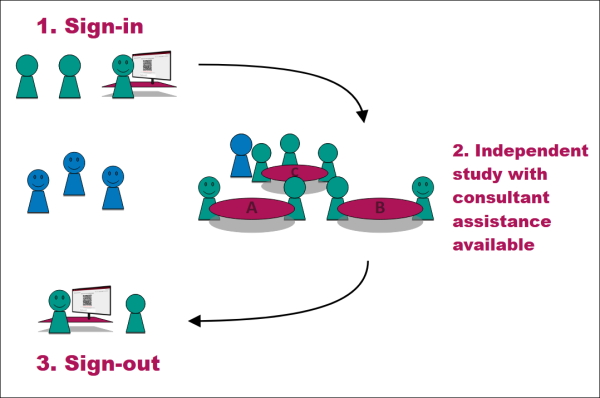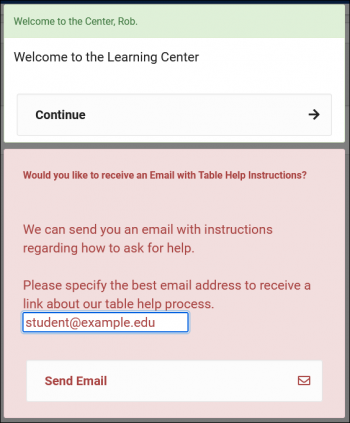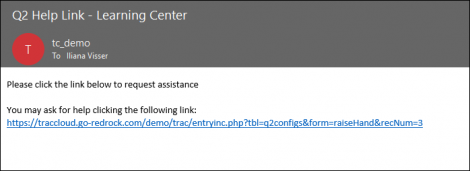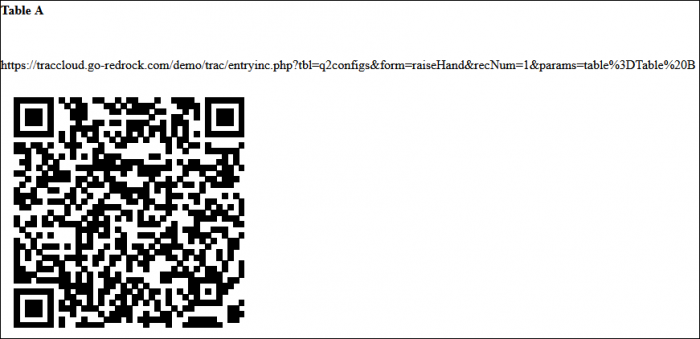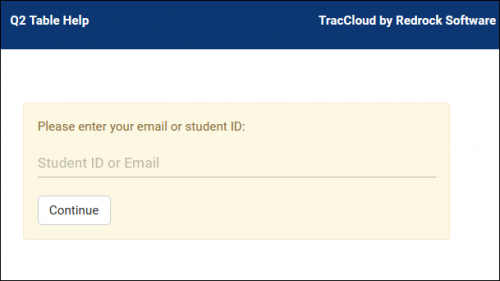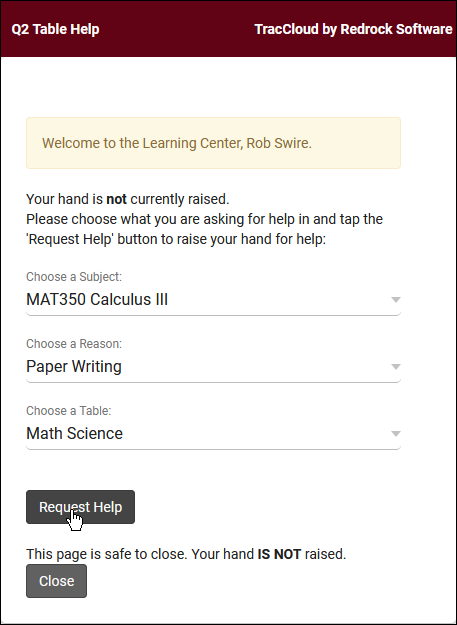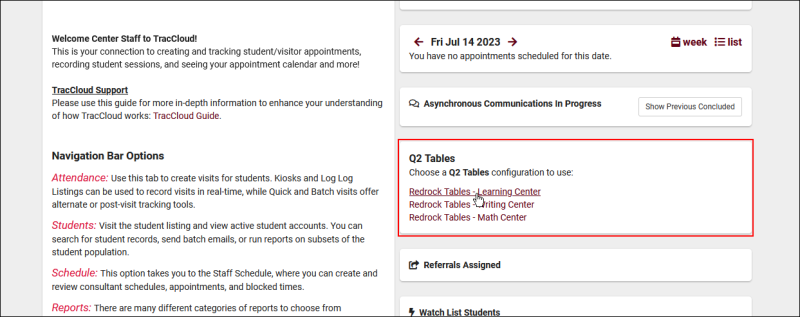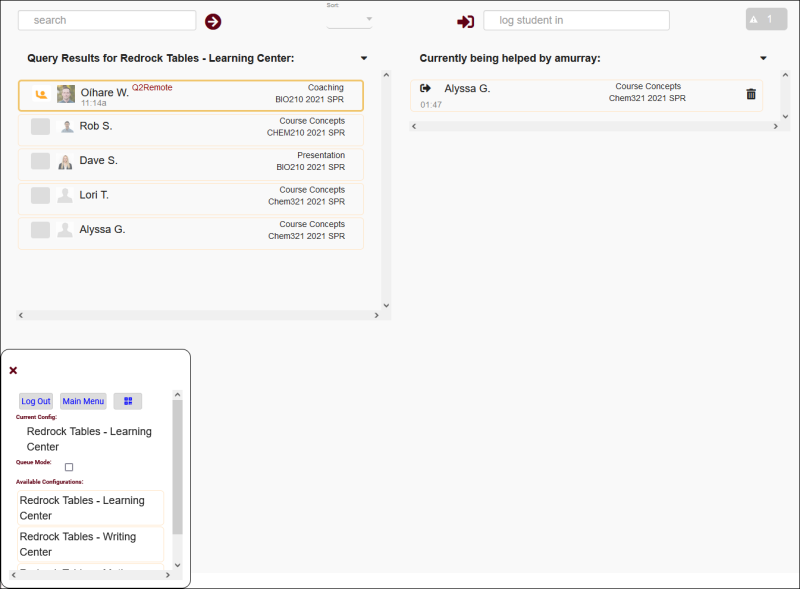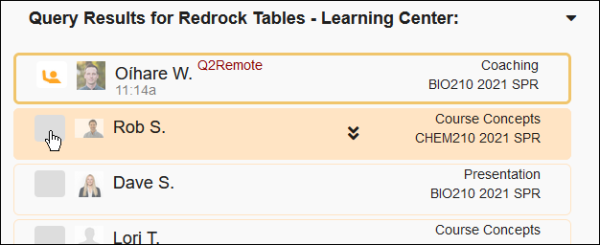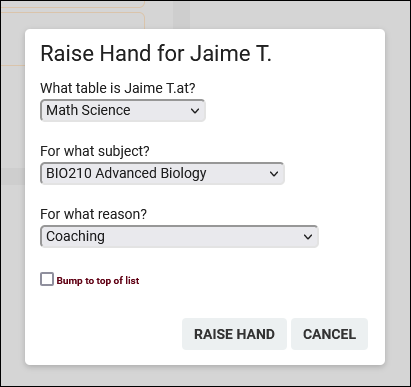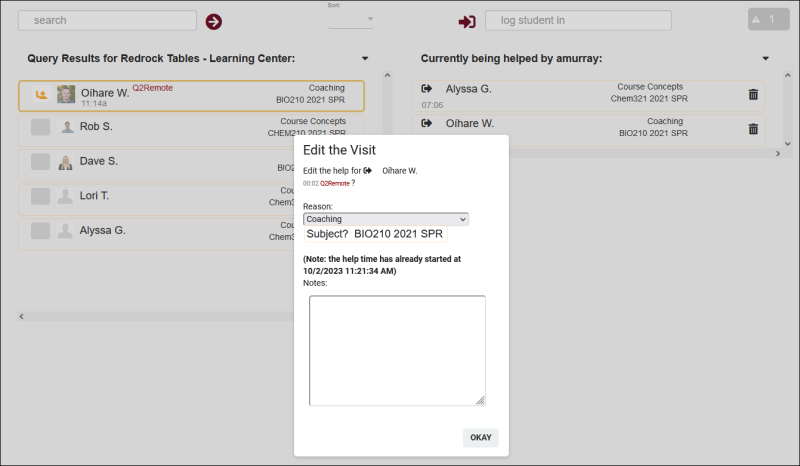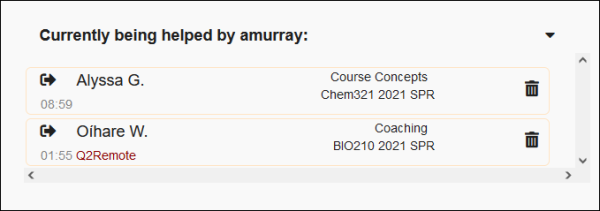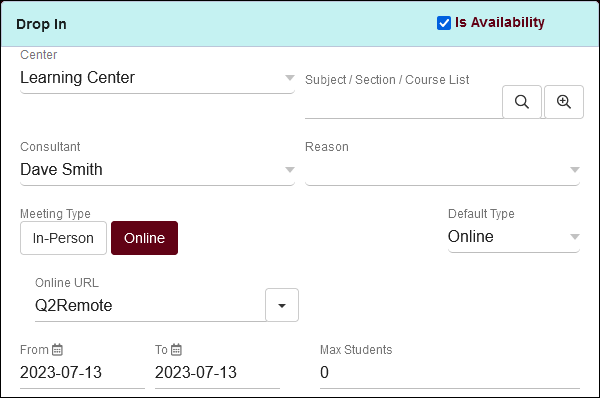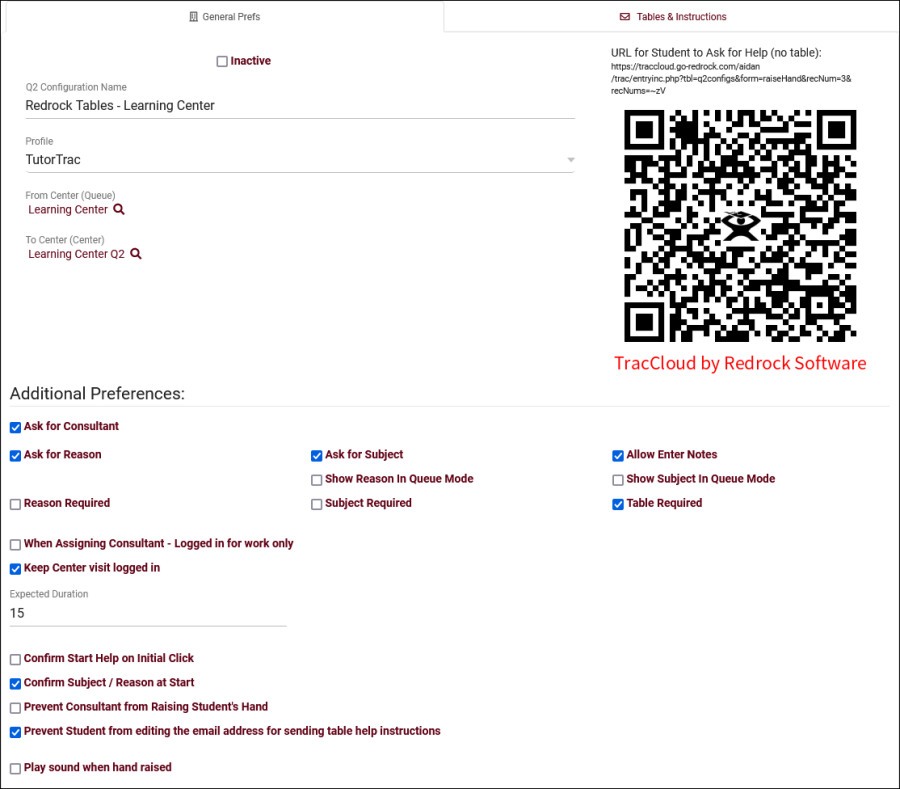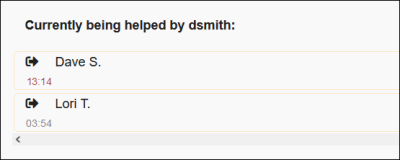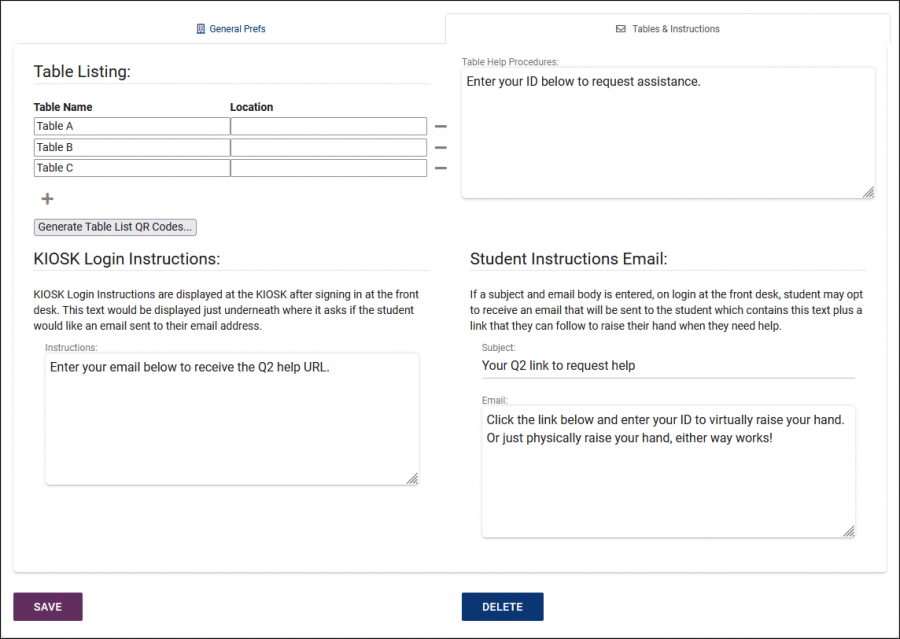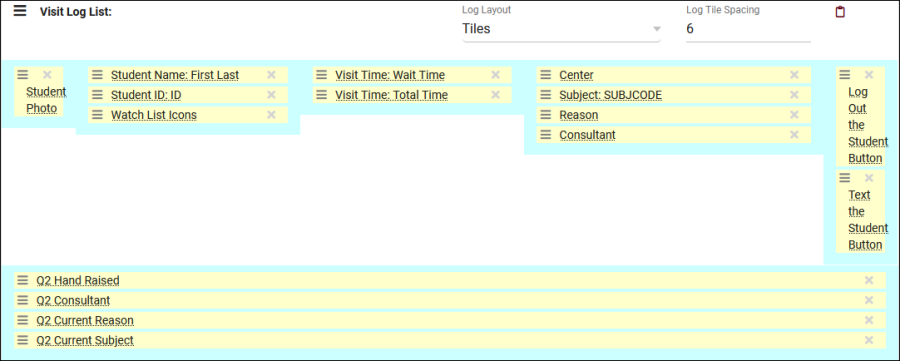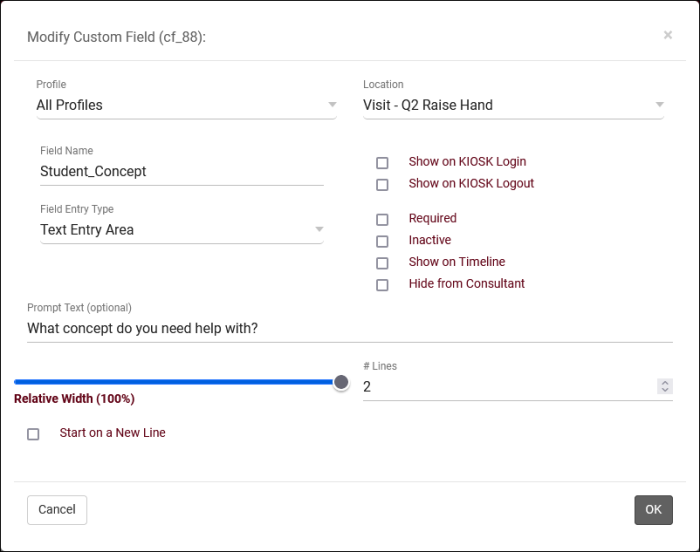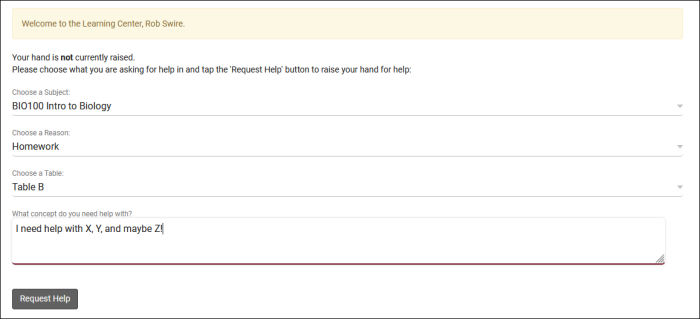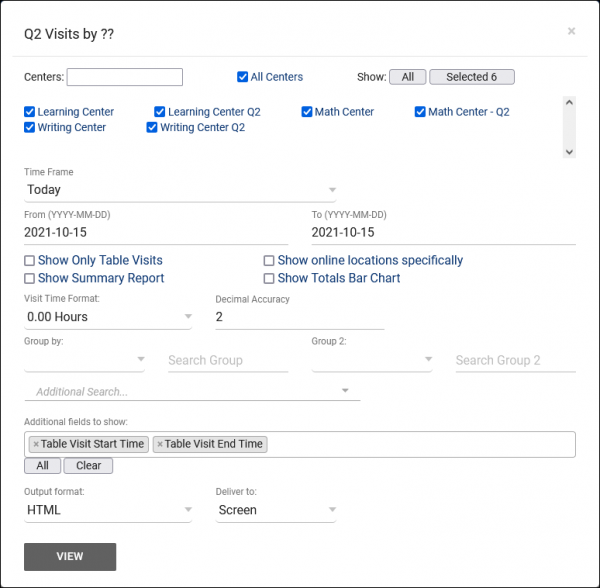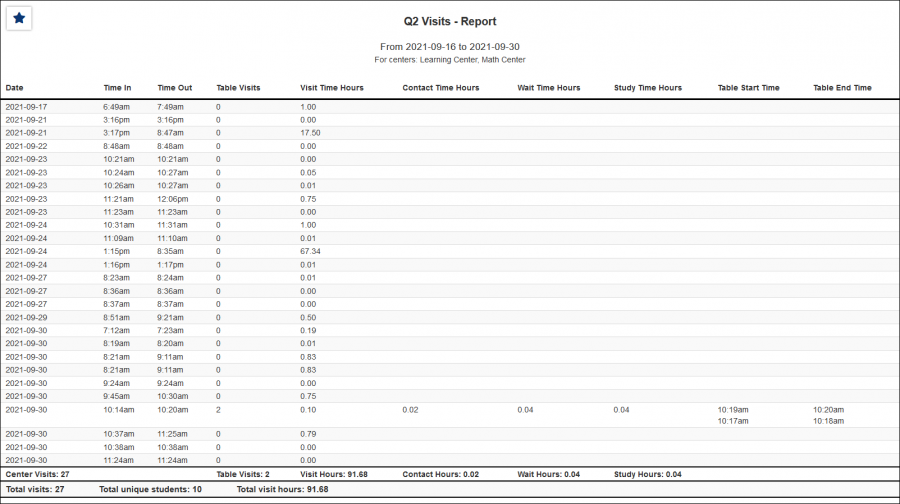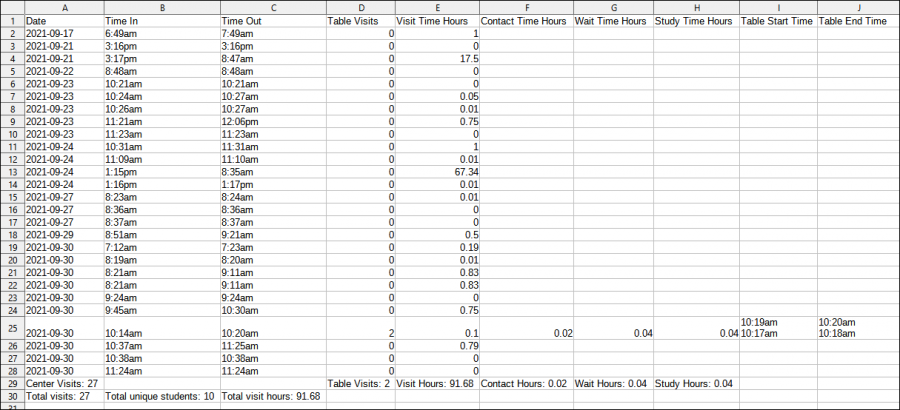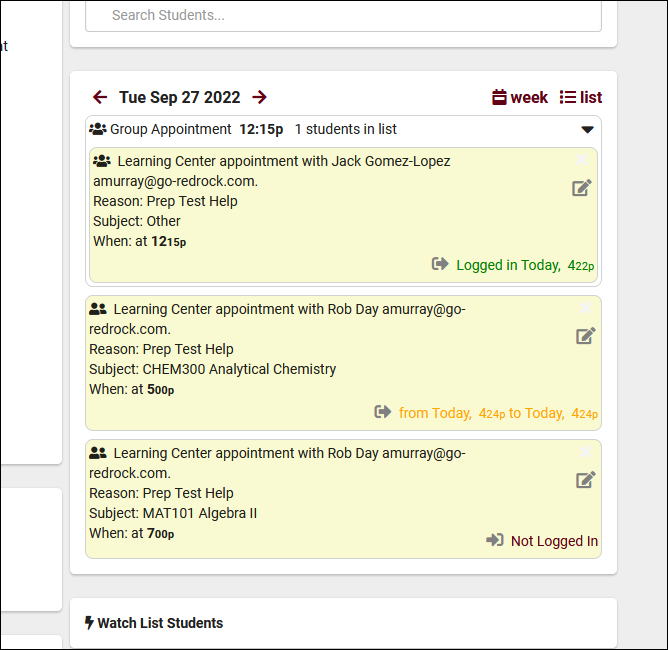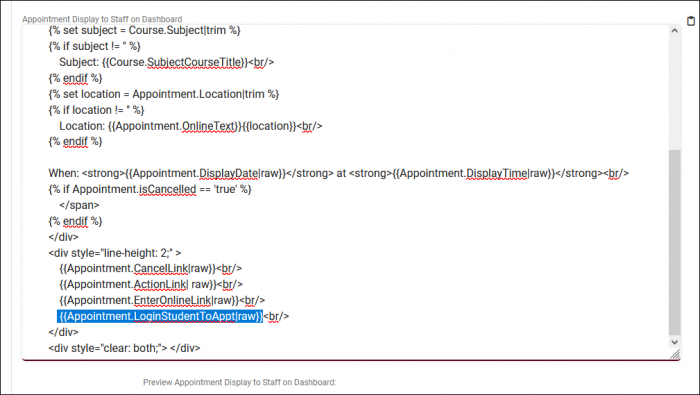TracCloudWhatsNew
From Redrock Wiki
This page highlights some of the recent changes made to the TracCloud platform, and how you can utilize them on your own instance. A list of past changes and a full changelog can be found in the tabs above.
If you have any questions about these changes, feel free to reach out to us on our helpdesk.
Course Lists
Course Lists act as assigned sections or specialties in TracCloud, allowing you to determine which courses each of your consultants can assist with, and which courses are available in each center. Course Lists can additionally be assigned to availabilities as a form of section group, as seen towards the bottom of this article.
To manage your course lists, go to Other > Listings > Course Lists.
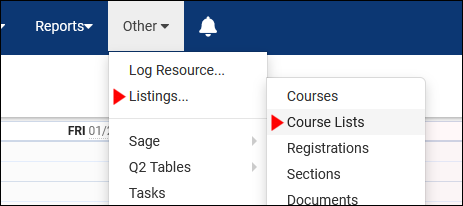
This will bring you to the Course Lists listing.
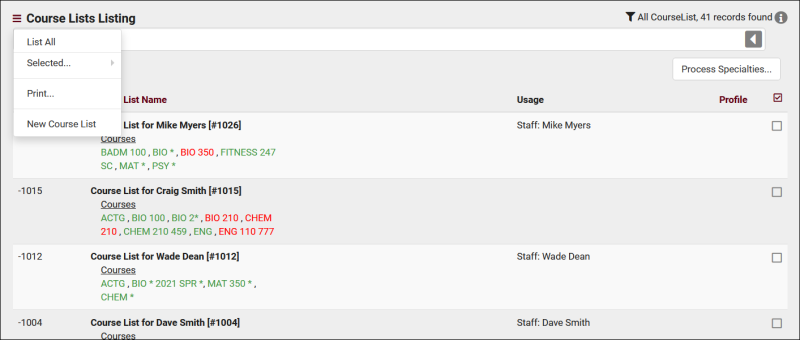
- Process Specialties allows you to re-scan for new courses that fall under the criteria of these lists. For example, if a list was created for Math 100 courses, but only sections 01 and 02 existed when it was created, you would need to re-scan to add the new 03 and 04 sections. This step is part of the TracCloud semester changeover process.
- The Hamburger Icon allows you to show all course lists after a search, print the list, or create a new list. Go ahead and click “New Course List” to begin.
After selecting New Course List, we’re brought to the following page, allowing us to name and customize our new list.
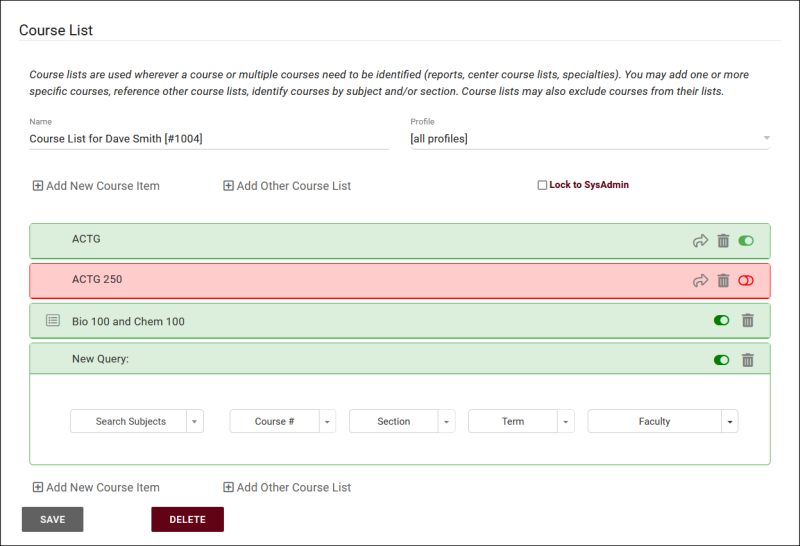
- Name will be what you’ll select when assigning this course list to your centers or consultants.
- Lock to SysAdmin will prevent non-sysadmin accounts from modifying this course list.
- Add New Course Item allows us to add a new subject query. We can be as specific as needed here, specifying up to the Subject, Course Number, Section Number, or Term Number, as well as faculty. For example, this allows us to create a course list of all ACTG250 courses, regardless of section/term, or simply all courses for writing center environments.
- Each course list item also has additional options, detailed below.
- Share will add this item to other selected course lists. More information on this can be found towards the bottom of this article.
- Delete will remove this item from the list.
- Toggle allows us to include/exclude the queried course(s). For example, you could create a course list of all MATH courses, and then create another Course Item for MATH 204 and set the toggle icon to off . This would result in the list containing all MATH courses except for 204.
- Toggle allows us to include/exclude the queried course(s). For example, you could create a course list of all MATH courses, and then create another Course Item for MATH 204 and set the toggle icon to off . This would result in the list containing all MATH courses except for 204.
- Add Other Course List allows us to include/exclude the contents of an entire other course list. Consultant course lists (designated with the sequence number in the name) should not be added to other course lists.
As an example, we’re going to create a course list for one of our consultants. This consultant can assist with all Accounting 100 courses, except for section 386. Here’s how we would write that out.
To start off, we’re including all ACTG 100 courses, ignoring section (wildcard), term, and faculty.

At this point, we can manually add another entry for section 386 and click the toggle icon to exclude the course. Alternatively, we can scroll down to view the sections that will be included in this list, where we can see section 386. We can immediately exclude this course by clicking the remove icon on the right-hand side.
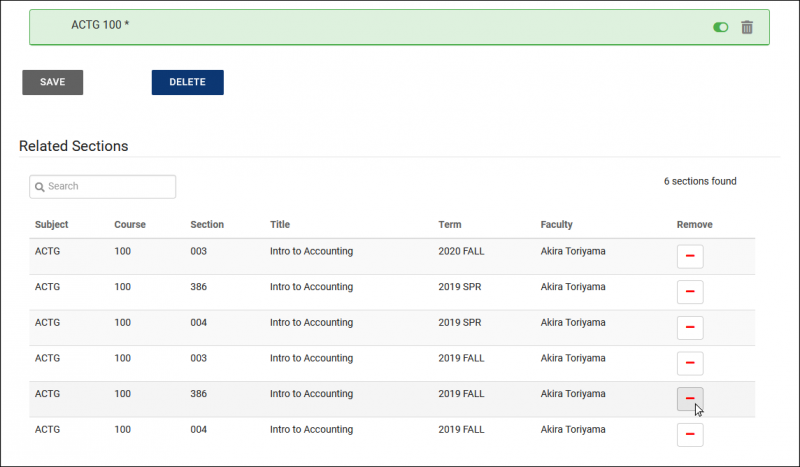
Clicking the icon prompts us to choose how specific we want to be with this exclusion. For our scenario, we would select “Remove ACTG 100 386.”
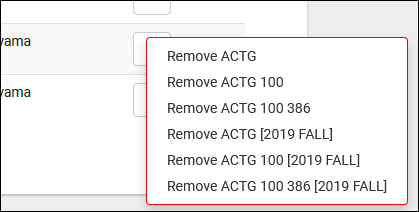
This will add the new item to the list automatically, excluded by default.

Center course lists are used to filter availability searches and affect what section options are available when creating availabilities and booking appointments from the dashboard, in addition to consultant specialties. In your Center entry window, you will see the highlighted options below.
Other > Other Options > Profiles > [Your Profile] > Centers > [Your Center]
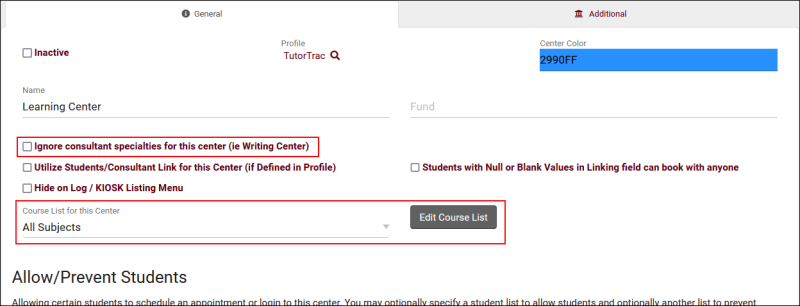
- Ignore consultant specialties for this center
During the kiosk login or appointment booking process, students are asked what subject they need assistance with. When you select a consultant, the list of available subjects/reasons is restricted based on what the consultant is assigned to. By checking this box, these specialties are ignored, and a student can choose any subject/reason/consultant combination, only restricted by what’s assigned to the center itself. Typically used for writing centers.
- Course List for this Center
This option controls the courses assigned to this center. If you have a Math center, you may want to assign a course list containing all MATH courses. A writing center may have all sections assigned, etc.
Managing course lists for consultants is exactly the same as centers, with one exception. Consultants have course lists by default. After you create a new consultant account (Other > Listings > Staff > [Consultant] > Scroll down to "Course List of Specialties"). The consultant's default course list will always be the last option in this drop-down menu, even if you haven't created it manually. After selecting their course list, you can click the Edit button to immediately start modifying it, at which point it's exactly the same as described above.
Another utility available for Course Lists is the ability to share items to other lists, effectively a way to make bulk changes to your specialties by adding or removing sections as needed. For example, if you recently added a non-enrolled course, this allows you to quickly assign it to everyone without editing every list individually.
First, use the selection buttons on the Course Lists listing to choose which Course Lists you want to share an item with.
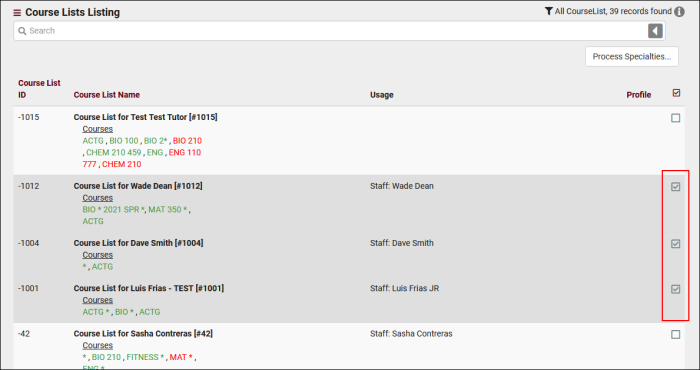
Second, open a Course List that contains the item you want to share. Click the arrow button on that item, and you will be shown a confirmation window. Clicking "OK" here will immediately add that item to your selected Course Lists.
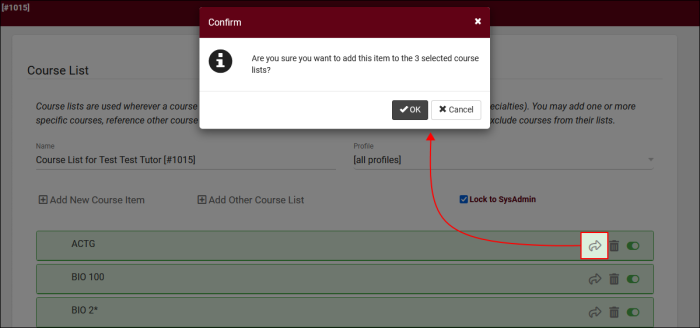
Another use for Course Lists is as section groups for availabilities. For example, if you have a tutor who is available for MATH, ACTG, and CHEM, but you want to create an availability for MATH and ACTG exclusively, you would need to use a course list. The ability to link course lists to availabilities must be enabled in global preferences first by going to Other > Other Options > Preferences > Search Availability Options > Additional Settings > Allow Course Lists to be assigned to availabilities.
Once enabled, a new search glass icon will be shown in availabilities. You will be able to choose any course list that is assigned to the same profile that the center of the availability is in. Course lists designated as "All Profiles" will not appear in this list.
Profile Preferences
Prefs
Reasons
Reasons/Services allow your staff and students to provide additional information and reasons for booking an appointment. For example, reasons such as “Counseling,” “Study Plan Help,” or “Exam.” This would let the consultants know what the student needs help with, provide preparation details and information as needed, and gives your staff additional information for reports. Reasons can be managed by going to Other > Other Options > Profiles > [Your Profile] > Reasons.
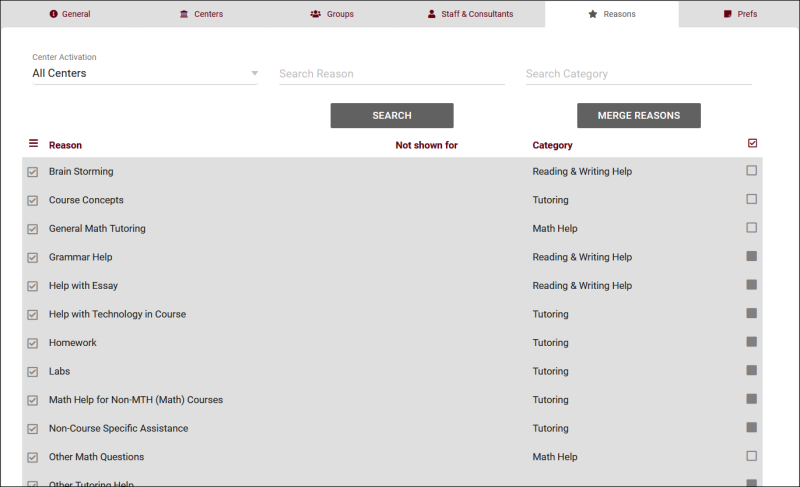
The hamburger icon contains several management options, detailed below.
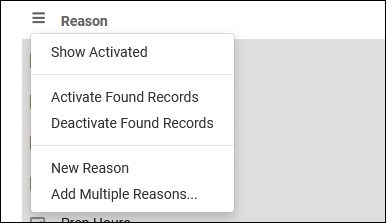
- Show Activated
- This will display globally activated reasons (left-side checkbox).
- This will display globally activated reasons (left-side checkbox).
- Activate/Deactivate Found Records
- Activate/Deactivate reasons in bulk, based on your last search result.
- Activate/Deactivate reasons in bulk, based on your last search result.
- New Reason
- Create a new reason.
- Create a new reason.
- Add Multiple Reasons
Creating Reasons
Click on the hamburger button, then select “New Reason” to be brought to the Reason creation menu.

- Profile
- By default, the profile we started creating this reason in will be selected, however, we can change this value or even choose “Available for All Profiles.”
- By default, the profile we started creating this reason in will be selected, however, we can change this value or even choose “Available for All Profiles.”
- Reason
- The name of the reason, this will be what’s selected by students or staff during appointment scheduling and kiosk logins.
- The name of the reason, this will be what’s selected by students or staff during appointment scheduling and kiosk logins.
- Category
- The category this reason is assigned to. More information on this can be found further into this article.
- The category this reason is assigned to. More information on this can be found further into this article.
- Sort Code
- Manually specify how your reasons are sorted during login or appointment search. This can be numeric, or you can simply paste your reason name to sort alphabetically.
- Manually specify how your reasons are sorted during login or appointment search. This can be numeric, or you can simply paste your reason name to sort alphabetically.
- Log Out Method & Visit Time
- There are three Methods available.
- Auto Logout After Time, which will automatically log the student out of the center when the time specified in Visit Time is reached.
- Auto Logout Immediately will log the student out immediately after they’re logged in and create a visit record of the length specified in Visit Time.
- Notify Time Expired, which will send out an email based on the checkboxes used when the time limit is reached. The contents of this email will be determined by your 'Visit Duration Notification' email in your Profile Prefs.

- There are three Methods available.
- Inactive
- We never recommend deleting records in TracCloud, as this removes them from reports and related records. In the event that you are no longer utilizing a reason, you’ll want to check the Inactive box instead of deleting it to keep the records available and accurate.
- We never recommend deleting records in TracCloud, as this removes them from reports and related records. In the event that you are no longer utilizing a reason, you’ll want to check the Inactive box instead of deleting it to keep the records available and accurate.
- Work Reason
- Work reasons allow consultants to login to TracCloud and track their work hours. This data will then be available to users with appropriate permissions via payroll reports. For more information on payroll tracking in general, click here.
- Work reasons allow consultants to login to TracCloud and track their work hours. This data will then be available to users with appropriate permissions via payroll reports. For more information on payroll tracking in general, click here.
- Ignore Section Specialties when Searching Availabilities with this Reason
- This functions similarly to the 'Ignore Specialties' options in Centers. If a student is searching for availabilities and selects a Reason with this checkbox enabled, they will see all consultants assigned to this Reason regardless of subject chosen. Typically used for Writing or Coaching-related Reasons.
- This functions similarly to the 'Ignore Specialties' options in Centers. If a student is searching for availabilities and selects a Reason with this checkbox enabled, they will see all consultants assigned to this Reason regardless of subject chosen. Typically used for Writing or Coaching-related Reasons.
- Do NOT SHOW for Students (staff only)
- If checked, this Reason will only appear for staff who are booking appointments on behalf of students. Students themselves will not see this Reason.
- If checked, this Reason will only appear for staff who are booking appointments on behalf of students. Students themselves will not see this Reason.
- Do NOT SHOW for Appointments
- Do NOT SHOW for KIOSKS
- Do NOT SHOW for Batch Visits
- Don’t show this reason under these specific circumstances.
- Don’t show this reason under these specific circumstances.
Assigning Reasons to Centers
There are two ways to assign Reasons to your Centers, first is directly from this tab in your Profile. The checkbox button on the right-side allows you to activate/deactivate reasons for the center selected in the top-left corner, or display all activated reasons for the selected center. This can also be used with “All centers” selected, allowing you to quickly add or remove a reason from all of your centers.

Reasons can also be assigned from your Center directly. From your Profile, click on the Centers tab followed by the Center you want to update. The very last option on this page is 'Active Reasons,' allowing you to add or Remove reasons for this specific Center.

Reason Categories
Categories allow you to group different reasons together. If you have several reasons available, it can be beneficial to group them into categories that staff and students can select when booking appointments.
These Categories will appear followed by “…”, which when clicked will prompt you to choose a Reason within the category.
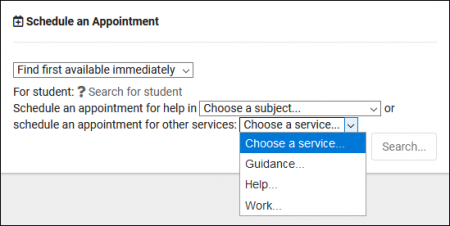
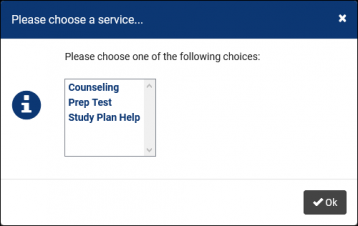
As an example, a “Placement Assessment” category that contains different assessment reasons for each course. A “Note-Taker” category, “Make-Up,” etc. If you have multiple reasons that would be better grouped together, putting them in the same category allows for improved organization and an easier appointment booking process for staff and students.
See Also
- Log In/Out Preferences - To require users select reason during visit login.
- Search Availability Options - To require users select reason during appointment searches.
- Staff & Consultants - Assigning reason specialties to staff.
Custom Lists, Dynamic Lists, & Watch Lists
Lists are used to group an arbitrary selection of students together. These lists can be used for a variety of reasons, from simply viewing a set of students, to sending mass emails, running reports, or even limiting a permission group’s student listing access to only a certain population of students. If you want to make a student stand out on the log listing or student listing, assigning them to a watch list is a great way to accomplish this. There are three types of lists in TracCloud, detailed below.
Static List
- Static lists are managed manually. If an individual student or a set of students need to be added or removed from a list, they will need to be added/removed by a user with the appropriate permissions. Max appointment rules can also be configured to add students to lists automatically, more information on these rules here.
- Static lists are managed manually. If an individual student or a set of students need to be added or removed from a list, they will need to be added/removed by a user with the appropriate permissions. Max appointment rules can also be configured to add students to lists automatically, more information on these rules here.
Dynamic List
- Dynamic lists are updated automatically based on a student search. For example, you can search for all students with a major of X and a class of Y, and a dynamic list created based on that search will keep itself up to date as that search result changes overtime. You can even base a dynamic list on a student search for other custom lists.
- Dynamic lists are updated automatically based on a student search. For example, you can search for all students with a major of X and a class of Y, and a dynamic list created based on that search will keep itself up to date as that search result changes overtime. You can even base a dynamic list on a student search for other custom lists.
Watch Lists
- A watch list can be based on any custom list, static or dynamic, and adds an indicator next to the student's name in a few different locations to make them stand out compared to students not on a watch list. These otherwise share the same functionality as the custom list they're linked to.
- A watch list can be based on any custom list, static or dynamic, and adds an indicator next to the student's name in a few different locations to make them stand out compared to students not on a watch list. These otherwise share the same functionality as the custom list they're linked to.
In order for a user to view or edit a student list, the list must be assigned to their permission group. It's also worth keeping in mind that only SysAdmins are allowed to create lists in the first place.
Creating Static Lists from System Preferences
Within your global preferences, you will find the "Custom Lists" menu. This allows you to view the custom lists that have been created in your Trac System, which can be renamed, deactivated ("!" button), or deleted if needed. Deactivated lists no longer appear on the student list/reports, but can be reactivated later if needed. A new custom list can be created by clicking the + icon, only static lists can be created from this menu. For existing dynamic lists, you can view or edit the query by clicking the button.
Other > Other Options > Preferences > Custom Lists
Creating Static & Dynamic Lists on the Student Listing
Managing lists directly from the student listing is also possible and provides you the ability to create dynamic lists as well, which allow you to have an always-up-to-date list of students for any purpose.
Before creating a list, you will almost always start with a search. This can be any search, from entering a student's name in the search bar, to power searches, and even utilizing the "Show These Students" options using the registrations or visits listing as a source. As an example, the power search in the screenshot below would show all students with a Major of “Mathematics” and a status of “Active."
After you've reached the search results page, click on the hamburger icon > Lists, where you will find the following options.
- Create New Static List
- This will create a new static list and assign all students from your current search to itself. This list will not be updated automatically going forward. You will be prompted to enter a name for the list on selection.
- This will create a new static list and assign all students from your current search to itself. This list will not be updated automatically going forward. You will be prompted to enter a name for the list on selection.
- Create New Dynamic List
- This will create a new dynamic list based on your last search (e.g., Major and Status), and will keep itself up to date going forward based on that search. If a student changes majors, they will be removed, if a new student is imported with this major, they will be added, etc. You will be prompted to enter a name for the list on selection.
- This will create a new dynamic list based on your last search (e.g., Major and Status), and will keep itself up to date going forward based on that search. If a student changes majors, they will be removed, if a new student is imported with this major, they will be added, etc. You will be prompted to enter a name for the list on selection.
- Add these to...
- This allows you to quickly add your current selection of students to an existing static list.
- This allows you to quickly add your current selection of students to an existing static list.
- Remove these from...
- This allows you to quickly remove your current selection of students from an existing static list.
- This allows you to quickly remove your current selection of students from an existing static list.
- Find Not On List...
- This will further filter your selection of students by those who are not on another list (static or dynamic).
- This will further filter your selection of students by those who are not on another list (static or dynamic).
- Delete List...
- This allows you to quickly delete a list from your system.
- This allows you to quickly delete a list from your system.
Beneath these options you will also see all other lists that you have access to. Clicking a list will immediately display those students.
List Categories
Lists can be grouped into categories for further organization. The name of your list should be in the format of Category::List Name. See example below.
How it appears on the Student Listing:
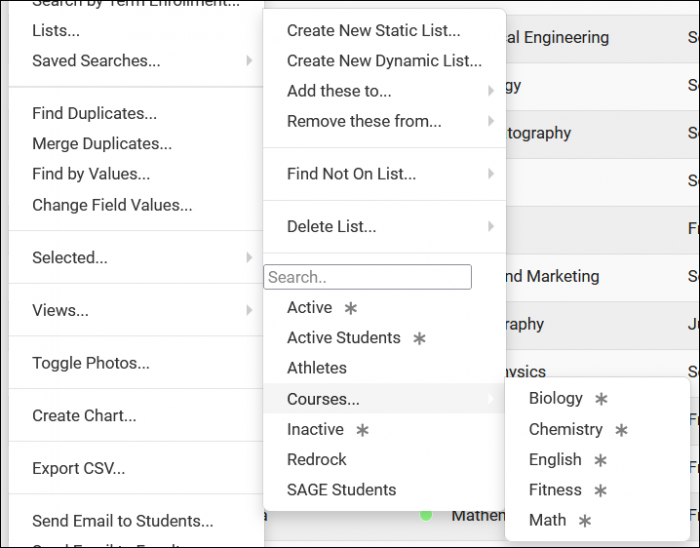
Creating Watch Lists
To create a new watch list indicator, head over to your global preferences, select "Watch Lists," and click the + icon. This will add a new watch list, clicking on the name lets you rename it, selecting the colored box lets you change the indicator color, and the box next to that determines which custom list this watch list is assigned to. After you’ve given it a name, color, and list, select the right-arrow to control where these indicators appear. Watch list indicator icons refresh daily at 4am, which can be changed here as well if needed.
Other > Other Options > Preferences > Watch Lists
Watch List Indicator Locations
The watch list indicator can be configured to display in various locations throughout the Trac System. Hovering over the indicator also provides the list name.
- Display on Log In/Out
- Displays in the upper-right corner of the login/logout process on the log listing.
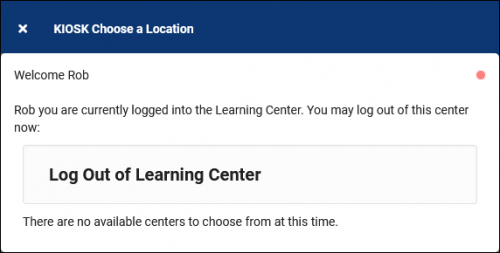
- Display on Entry
- Display on Listing
- Displays the indicator on the student listing.

- Display on Appointment
- This makes the indicator visible during availability searches as a staff member, within appointment entry windows, and in group rosters.
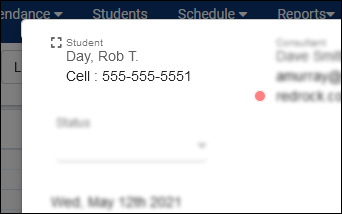
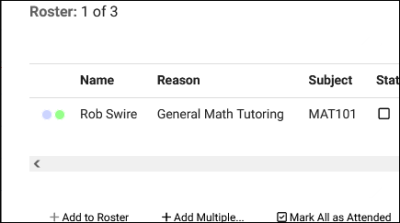
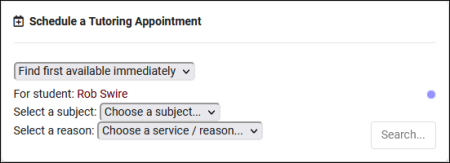
- Display on Dashboard
- This will allow the list to be visible from the staff dashboard, within the “Watch List Students” box. Requires "Show the Watch Lists on Main Menu" to be enabled in the staff member's linked permission group.
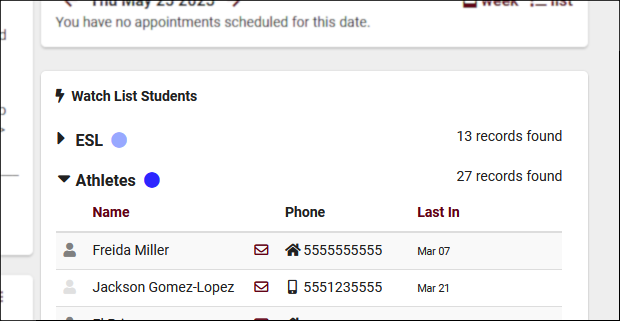
- Display on KIOSK login/out
- Displays in the upper-right corner of the login/logout process on the kiosk.

2022-12-08 | Terms and Conditions Response Listing
You can now view a list of students who have accepted your terms and conditions records, including the date of acceptance, active semester, subject, and initials. This can be viewed from your existing Terms and Conditions records in Other > Listings > Terms and Conditions > [Your Terms] > Responses.
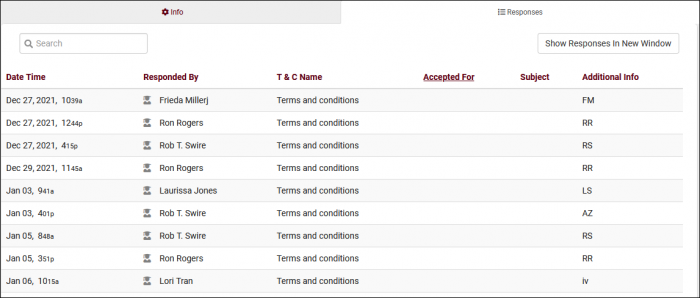
Search Availability badges can be used to add information and indicators to availability slots. Each badge can appear for certain conditions, based on center, availability section/reason, location, skills/accommodations, etc.
Click "New Availability Badge" to begin. This will open a form where you can enter the details for your badge.
Manually Linked
Name
- Name of the Badge. This will not be displayed for students
- Name of the Badge. This will not be displayed for students
Availability Type
- Drop In, 1-on-1, or Group availability
- Drop In, 1-on-1, or Group availability
Consultant
- Assign a specific Staff
- Assign a specific Staff
Reason
- Assign a specific Reason
- Assign a specific Reason
Center
- Assign a specific Center
- Assign a specific Center
Section
- Assign a specific Subject
- Assign a specific Subject
Special Needs
- Select if applicable (more information)
- Select if applicable (more information)
Online
- Availability Type; Online, In Person, or Optional
- Availability Type; Online, In Person, or Optional
Location
- Location of the availability
- Location of the availability
Once you've decided where the badge is needed and have made your selections from the options above, you can now determine which icon, colors, and info work best for the badge created.
Color: Color of Icon
Icon: Choose from the list or use a custom icon
Info Text: Enter text that will display when users hover over the icon
In the example screenshot above, this badge will only appear on availabilities of staff who have been assigned the “ASL” accommodation and are available in the Learning Center. Once saved, your badge will appear in the profile preferences if you need to edit/delete it later.
Any fields left blank will not be considered for where this badge appears, you can be as specific or non-specific as needed. You can also create as many badges as you'd like, more than 1 tag can appear for the same availability. When students search for an availability, the badges will display to the right of the screen as shown below.
2022-12-03 | Custom Fields on Q2 Raise Hand Menu
Custom Fields can now be assigned to the Q2 Raise Hand form to ask additional questions to your students when they're raising their hand. This question appears for Q2Remote, or when a hand is raised by staff from the Log Listing. The answers to these questions can be viewed on the Q2 queue page by expanding the relevant entry in the list (second screenshot below).
Instructions on configuring Custom Fields in general can be found here.
2022-11-16 | Custom Consecutive Appointment Limit
You can now choose a custom threshold for when consecutive appointments will be blocked. If "Prevent [user type]" is checked and this box is left blank, the default value is 2, meaning students are not allowed to book consecutive appointments. 3 would allow 2 consecutive and block the third.
This option is found in Other > Profiles > [Your Profile] > Prefs > Scheduling > Time Restrictions > Prevent # consecutive.
2022-11-16 | Cancellation Grace Period
You can now add a grace period for cancellations. If a student books an appointment, and needs to cancel ~5 minutes later, you may not want that to count towards any maximum cancelled appointment rules. If a student cancels within the number of minutes specified here, the appointment will be deleted instead of set to a cancelled status.
This option can be found in Other > Profiles > [Your Profile] > Prefs > Scheduling > Time Restrictions > Allow cancellation/deletion of new appointment within x minutes.
2022-11-04 | Set a Custom Auto-Cancellation Threshold
You can now change your threshold of missed/canceled appointments to auto-cancel the remainder of an appointment series. This can be found in Other > Other Options > Profiles > [Your Profile] > Prefs > Scheduling > Other Schedule Options. If left blank, TracCloud will use the previous default of '2' for both of these preferences.
2022-11-04 | New Auto Termination Options
Additional options have been added to Auto Termination settings to provide better flexibility in how this feature applies to your visits.
There are now two parts of this process. The first, Terminate all still logged in, will only conclude visits that are still in-progress by your Time for Nightly Termination. The second, Auto terminate visits longer than, also applies to on-going visits that meet this criteria, however, this additionally applies to concluded visits. For example, if a user created a 10-hour visit for one of your students, this process will change it back to your defined time.
Other > Other Options > Profiles > [Your Profile] > Prefs > Log Listing Message[...] > Auto Termination.
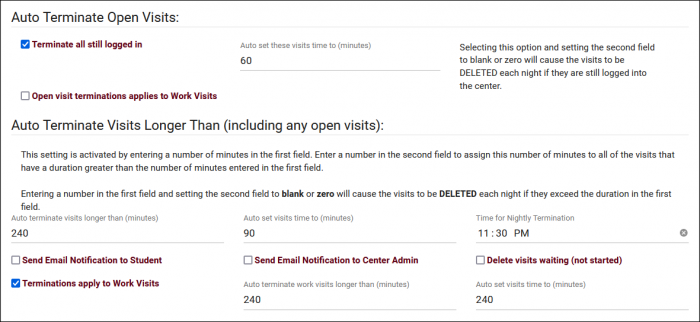
- Terminate all still logged in
- If enabled, any on-going visits by Time for Nightly Termination will be concluded and set to your defined duration.
- Auto set these visits time to (minutes)
- If an on-going visit is terminated, this is the duration it will be set to.
- Open visit terminations applies to Work Visits
- Also apply the above logic to consultant Work Visits as well.
- Auto terminate visits longer than (minutes)
- This part of the process will also affect concluded visits as described earlier. This should be set to your maximum possible visit duration to prevent accurate visits from being adjusted. Leave this and Auto set visits time to blank to disable this part of Auto Termination.
- Auto set visits time to (minutes)
- This is the duration visits will be changed to in the above scenario. Leave this and Auto terminate visits longer than blank to disable this part of Auto Termination.
- Time for Nightly Termination
- This is the specific time the Auto Termination process runs each day. This process only applies to visits on the current day, so it should not be set later than 11:59pm.
- Send Email Notification to Student / Center Admin
- Toggling these options will send an email to the student and/or center admin letting them know that the student wasn’t logged out.
- Delete visits waiting (not started)
- If a 'Waiting' status visit reaches the auto-termination window, you can choose if it's terminated normally (unchecked) or deleted (checked).
- Terminations apply to Work Visits
- If you would like to also terminate work visits, you can check this box and define a different threshold and adjusted time.
2022-10-06 | New Options for Late Cancellation Notices
If a student attempts to cancel an appointment within the time limit defined by your profile, it will be counted as a Missed appointment. Two new options have been added to your Profile Settings to further customize the behavior of this feature. Other > Other Options > Profiles > [Your Profile] > Prefs > Scheduling > Appointment Status and Management.
- Status for late cancellation
- If left blank, a late cancellation will be recorded as "CANCEL - MISSED" (or your Profile's version of the "Missed" phrasing). You can use this to change the phrasing of this status entirely, but make sure to include the word "Cancel" somewhere in the status otherwise TracCloud will not send a cancellation email or open the time slot for other students.
- Additional text message for late cancellation prompt / warning
- This is an optional additional message that displays to students when they are cancelling an appointment outside of your time restriction. This appears in addition to the standard "This will be marked as missed" notice.
2022-10-04 | Include labels in selected SAGE Reasons/Recommendations
Two new Twig arrays have been added, ReasonsAndLabels and RecommendationsAndLabels, which can be used to include labels in your SAGE emails.
The standard Reasons and Recommendations arrays will look like this when sent over email.
Reasons selected:<BR>
{% for key,value in Reasons %}
{{ value }} <br>
{% endfor %}
ReasonsAndLabels and RecommendationsAndLabels will look like this.
Reasons selected:<BR>
{% for key,value in ReasonsAndLabels %}
{{ value }} <br>
{% endfor %}
if statements can also be used to further format the labels.
Reasons selected:<BR>
{% for key,value in ReasonsAndLabels %}
{% if value == "Grade" or value == "Attendance" or value == "Engagement" %}
<i><b>
{% endif %}
{{ value }} <br>
{% if value == "Grade" or value == "Attendance" or value == "Engagement" %}
</i></b>
{% endif %}
{% endfor %}
Q2 Tables
Q2 Tables offers a unique approach to attendance tracking specifically for study table centers, tracking the total time a student spends in the center in addition to recording the individual table visits where students received help from consultants. Students begin their center visit studying independently, while having the ability to request assistance as needed. Q2 offers the ability for students to virtually raise their hand and specify what they need help with, which consultants will be notified of. Smartphones and tablets drive the queuing system, for both students requesting help and staff viewing which students need assistance while recording table visit time.
At any point during a student's independent study time, they can request help. This is a three-step process.
- 1. The student opens the help request link from their email or scans a nearby QR code, enters their ID number, then specifies what they need help with and which table they're at.
- 2. A consultant sees that the student has requested help for a subject they can assist with. The consultant will go to that table (or send an online invite link for a virtual session) and begin the table visit.
- 3. Once the student has received all the assistance they need, the consultant will conclude the table visit. This process can repeat if the student needs more help later.
Usage
The end-user perspective of Q2. Students requesting and receiving help, with staff managing table visits, recording notes, and more.
A student logs into a Q2 center ("From Center") to record the start of their visit. A staff member can log a student in manually, or the student can log themselves in via a kiosk using a barcode scanner, QR code, or by typing their student ID directly into the search field.
Upon login, students will be asked if they would like to receive an email regarding the Q2 request for help process. This email will contain a Q2 Help Link that students can use to virtually raise their hand, indicating that they need assistance from a consultant. This prompt will contain the student's TracCloud email address by default, but they can be given the ability to enter a preferred email address instead.
If the student chooses not to receive an email containing the Q2 Help Link, they will also have the option to scan a QR code placed by your staff nearby. These QR codes can be table-specific, or you can share a single generic QR code and allow the student to choose their table from a drop-down menu. Both options are generated in your Q2 config.
Once the student scans the QR code or clicks on the emailed Q2 Help Link, they will end up at the window below. Here, the student will be asked to enter their email address or student ID number to request help.
After the student enters their ID or email address and clicks the continue button, they will be prompted to fill in some additional fields to describe what they need assistance with. The option to select a subject and reason can be toggled on or off in your Q2 config settings, depending on whether or not that information is relevant for your Q2 use-case. Once the request for help has been submitted, the student will be moved into a queue only visible from the consultant’s perspective, which will display all students currently requesting help, indicated by a raised-hand icon.
Students can also physically raise their hand or ask someone for help, and a staff member can then virtually raise the student's hand for them by clicking the box to the left of the student's name, as seen in the next portion of this article.
Staff will be able to open the Q2 queue directly from their dashboard to view logged in students and who has their hand raised. The list of options will be based on their permission group.
The staff Q2 Dashboard is split into two columns. On the left, students in the center working independently or with other consultants, and whether or not their hand is raised requesting assistance. On the right, students currently being helped by the consultant viewing this page. Each column can be collapsed by clicking on the button, which can be useful on smaller screens.
The icon in the lower-left corner also offers additional options.
- Log Out & Main Menu are self explanatory, allowing the staff member to return to the dashboard or log out of their browser session.
- allows the user to quickly access all of the QR codes relating to this Q2 config.
- Queue Mode hides the "Currently being helped" column, students who don't have their hand raised, and additional details such as student photo. This can be displayed on a screen in the center so that students can see where they are in the queue if several students are requesting help at once.
- Available Configurations allows the user to quickly switch to a different Q2 config, still limited by their permission group.
Staff members can be allowed to manage student's raised hands, and either raise or lower their hand by clicking the space to the left of their name. If your system has any Q2 Raise Hand custom fields, they can be viewed by clicking the icon.
In both cases, an additional pop-up will open to ask for more information and confirm that you want to raise/lower their hand. "Bump to top of list" can be used to artificially add wait time to the hand raise so that they're sorted to the top of the list.
Clicking on the entry will start a table visit with the student. This will lower the student's hand automatically (if it was raised in the first place), and they will now appear in the "Currently being helped" column for the consultant. This will also open a pop-up menu to edit the table visit, allowing the consultant to adjust the reason/subject or enter notes. If this pop-up menu is closed, it can be re-opened by clicking on the table visit entry in the right column at any time. Keep in mind that table visits cannot be managed from more than one device or browser session at a time. The table visit must be started and concluded in the same session.
Once the consultant is ready to conclude the table visit, they can click on the icon to end the visit and move the student back to the left column as they continue to work independently. This will also give the consultant a chance to enter any final notes before concluding the visit. If the visit was started by mistake and the table visit needs to be deleted rather than concluded, the button can be used instead.
Q2 can also be utilized in an Online context. Your availability should look something like this, set to Drop-in, Online, with the Online URL set to Q2Remote. This can also be made a drop-down option by modifying your Default Online Options in Global Preferences.
As a student, I can search for and click on this Drop-in session as usual.
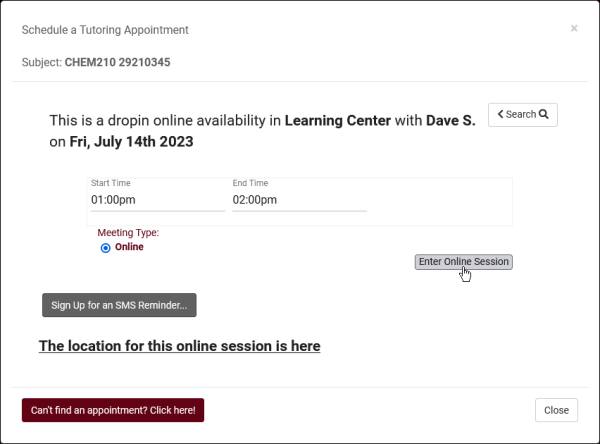
However, clicking 'Enter Online Session' in this case will take me to the following form rather than a meeting room. This allows me (the student) to specify what I need help with and virtually raise my hand, waiting at this form until a link is ready.
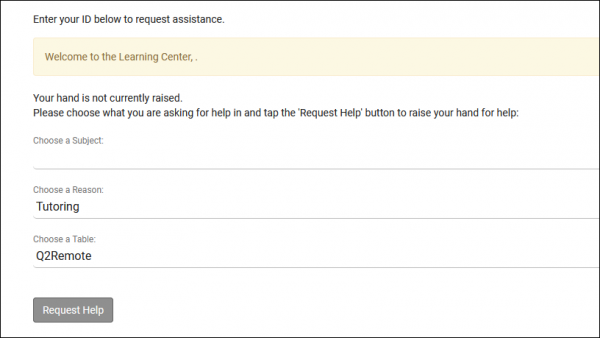
As a staff member monitoring this Q2 config, I can see a student has their hand raised for a remote session. Clicking on that entry prompts me to send them a remote meeting link, such as a Zoom or Webex room.

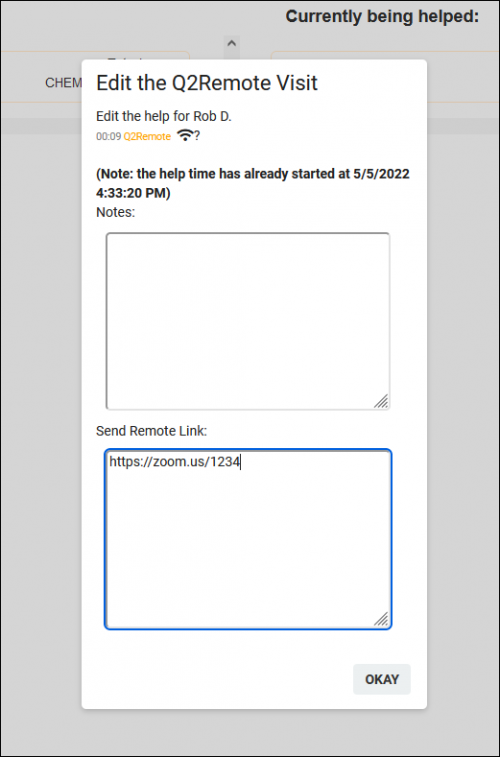
And once again as a student, I see that my meeting link is ready, which I can click to join. After the visit has concluded, the staff member will lower my hand as usual and the student can request help again if needed.
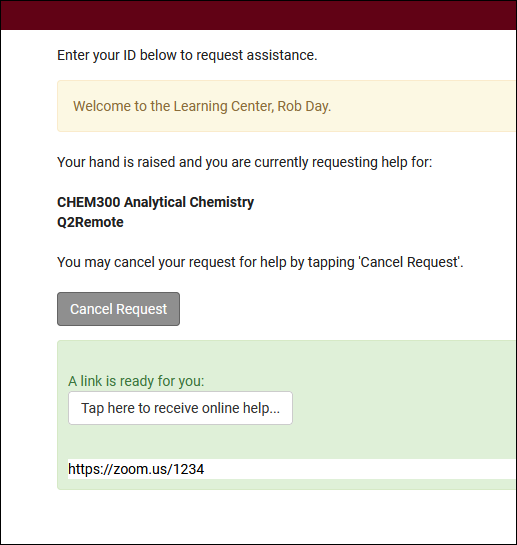
Q2 Configuration
Before you can track table visits, you will need to create your Q2 config and update group permissions to ensure that everything is configured to your needs.
To begin creating your Q2 Configuration. Click on Other > Q2 Tables: Configurations. Select the Hamburger icon and click New Q2 Configuration
- Q2 Configuration Name
- This is the name of this Q2 Config, which will appear on the dashboard to staff opening the Q2 queue.
- This is the name of this Q2 Config, which will appear on the dashboard to staff opening the Q2 queue.
- Profile
- This determines which profile this Q2 Config will be assigned to.
- This determines which profile this Q2 Config will be assigned to.
- From Center (Queue) & To Center (Center)
- Q2 requires two centers, a From Center (Queue) and a To Center (Center). The From Center/Queue is where the Trac System will record the total time a student spends in the center. The To Center/Center is where the Trac System records each individual contacts a student has with a staff member, also known as micro-visits or table visits.
- The From Center and To Center can both be created in your Profiles. Dashboard > Other > Other Options > [Your profile] > Centers > Create New Center. Your From and To centers will both need to be assigned a course list and reason(s), the same as your other centers.
- Ask for Consultant
- If checked, a consultant selection drop-down will be made available in the raise hand form for staff on the log listing specifically. This does not affect students who are raising their own hand.
- If checked, a consultant selection drop-down will be made available in the raise hand form for staff on the log listing specifically. This does not affect students who are raising their own hand.
- Ask for Reason & Ask for Subject
- If one or both of these options are checked, students (and staff on behalf of students) will be able to select a subject/reason when raising their hand. If checked, additional options will be made available to make each of these fields Required. Otherwise, it will be possible to leave these fields blank when requesting help.
- If one or both of these options are checked, students (and staff on behalf of students) will be able to select a subject/reason when raising their hand. If checked, additional options will be made available to make each of these fields Required. Otherwise, it will be possible to leave these fields blank when requesting help.
- Allow Enter Notes
- If checked, consultants will be able to enter notes during their table/micro visits.
- If checked, consultants will be able to enter notes during their table/micro visits.
- Show Reason/Subject in Queue Mode
- By default, these fields are hidden in the Q2 queue mode. These options allow you to display them.
- By default, these fields are hidden in the Q2 queue mode. These options allow you to display them.
- When Assigning Consultant - Logged in for work only
- If you allow your staff to raise student hands from the Log Listing (more information later in this article), they will have the ability to select a consultant to assign this request to. If this option is checked, only consultants currently logged in for work will be shown.
- If you allow your staff to raise student hands from the Log Listing (more information later in this article), they will have the ability to select a consultant to assign this request to. If this option is checked, only consultants currently logged in for work will be shown.
- Keep Center visit logged in
- This only applies to students logging in for Q2Remote drop-in sessions. If unchecked, a center visit is not recorded for students, only table visits. If checked, the first time the student goes to raise their hand will also log them into your center. That center visit must be concluded by a staff member or terminated automatically, students are not given the ability to manage their own visits.
- This only applies to students logging in for Q2Remote drop-in sessions. If unchecked, a center visit is not recorded for students, only table visits. If checked, the first time the student goes to raise their hand will also log them into your center. That center visit must be concluded by a staff member or terminated automatically, students are not given the ability to manage their own visits.
- Expected Duration
- Confirm Start Help on Initial Click
- If enabled, an additional step is added when beginning a table visit with a student to confirm that the visit should be started. Can be useful if staff are frequently accidentally starting table visits.
- If enabled, an additional step is added when beginning a table visit with a student to confirm that the visit should be started. Can be useful if staff are frequently accidentally starting table visits.
- Confirm Subject / Reason at Start
- If checked, consultants will be able to modify the subject/reason that was initially selected when the student raised their hand. This prompt will appear at the start of the table visit, when the consultant clicks on the students name in the list.
- If checked, consultants will be able to modify the subject/reason that was initially selected when the student raised their hand. This prompt will appear at the start of the table visit, when the consultant clicks on the students name in the list.
- Prevent Consultant from Raising Student's Hand
- Prevents consultants from raising students' hands on behalf of the students.
- Prevents consultants from raising students' hands on behalf of the students.
- Prevent Student from editing the email address for sending table help instructions
- Enforce that the Q2 help instructions prompt use the email address from their student profile, preventing them from using a different address.
- Enforce that the Q2 help instructions prompt use the email address from their student profile, preventing them from using a different address.
- Play sound when hand raised
- This will play a sound whenever a student raises their hand to get the attention of whoever is monitoring the queue.
- Table Listing
- This is where you can define the individual tables that students can request help from. Use Generate Table List QR Codes to display the QR codes for these specific tables. Table Locations can also be defined, which will be recorded for reporting purposes.
- This is where you can define the individual tables that students can request help from. Use Generate Table List QR Codes to display the QR codes for these specific tables. Table Locations can also be defined, which will be recorded for reporting purposes.
- Table Help Procedures
- This message will display when a student scans a QR code with their phone. The text will be visible immediately above the ID field.
- This message will display when a student scans a QR code with their phone. The text will be visible immediately above the ID field.
- KIOSK Login Instructions
- This message appears during the initial center login on a KIOSK or Log Listing. This text appears on the same screen where the student can email themselves the Raise Hand link.
- This message appears during the initial center login on a KIOSK or Log Listing. This text appears on the same screen where the student can email themselves the Raise Hand link.
- Student Instructions Email
- This is where you can customize the contents of the email sent to the student. The URL will always be included below the text you enter here. This field supports twig.
It is also possible to show Q2 information and options on the Log Listing for staff to manage. These options are found in Other > Other Options > Profiles > [Your Profile] > Prefs > Log In/Out > Log List Customization. This will only cover the Q2-specific options, for everything else, check out the dedicated Log List Customization article.
- Q2 Hand Raised
- This adds a 'Raise Hand' button to the Log Listing, allowing staff to raise or lower each student's hand. This will also display the table that the student has requested help at.
- This adds a 'Raise Hand' button to the Log Listing, allowing staff to raise or lower each student's hand. This will also display the table that the student has requested help at.
- Q2 Visits List
- This shows the student's currently ongoing table visits, if there are any.
- This shows the student's currently ongoing table visits, if there are any.
- Q2 Visit Flag
- If enabled, a wifi icon will be added to the log listing for students who are logged in for a Q2Remote session.
- If enabled, a wifi icon will be added to the log listing for students who are logged in for a Q2Remote session.
- Q2 Consultant
- Shows the name of the consultant that the student is requesting help with, or the name of the consultant who is currently helping the student.
- Shows the name of the consultant that the student is requesting help with, or the name of the consultant who is currently helping the student.
- Q2 Consultant Alias
- Shows the alias of the consultant that the student is requesting help with, or the alias of the consultant who is currently helping the student.
- Shows the alias of the consultant that the student is requesting help with, or the alias of the consultant who is currently helping the student.
- Q2 Current Reason/Subject
- These display the subject/reason the student is requesting help for.
- These display the subject/reason the student is requesting help for.
- Q2 Reason/Subject
- These display the reason/subject that the student is being helped with or was last helped with.
In order for staff to have access to Q2, their permission group will need to be modified and adjusted to enable that access. The Admin/Modules tab will allow you to add a Q2 Config to each group as needed. This can be found in Other > Other Options > Groups > [The group you want to modify] > Admin / Modules tab.
In the event that you need to create a custom question for students to answer while raising their hand, this can be accomplished with custom fields. To create a Q2 custom field, go to Other > Other Options > Preferences > Custom Fields. For more information on configuring custom fields in general, take a look at our dedicated custom fields article. In this case, make sure the location of your new custom field is set to "Visit - Q2 Raise Hand."
Once your question has been created, students will be prompted to answer it when they request help through Q2. As a staff member, you can view student answers on the Q2 query screen by clicking on the icon to the right of the student's name.
Q2 Report
There is currently one report available to view Q2 table visit data found in its own report category, Q2 Tables, detailed below.
This report provides an overview of visits that took place in your center, along with the contact time(s) for each center visit. More information on Q2 can be found here.
- Centers
- Filter report data by center. You can select all centers or only a specific few to narrow down your results. At least one center must be selected.
- Time Frame
- The date range for the data in this report. Beyond entering a date range manually, you can also choose a preset date range (Today, This Month, This Semester, etc) from the dropdown list above.
- Show Only Table Visits
- Only show Q2 Table visits specifically, exclude center visit records.
- Show Summary
- Only show data totals, excluding details of individual records.
- Show online locations specifically
- If unchecked, the 'Location' for online Appts/Visits will be displayed as simply 'Online.' If this option is checked, it will display the specific online location (e.g., 'https://zoom.us/123456789').
- Show Totals Bar Chart
- Adds a visual bar chart of totals to your report data.
- Time Format
- This determines the format of duration, a 90-minute session could display as 1.50, 01:30:00, or 01:30.
- Decimal Accuracy
- This determines the decimal accuracy of duration data. Defaults to 2, showing a 1-hour session as "1.00".
- Group by
- Group records by the selected field. Some reports allow you to add secondary and tertiary groupings as well.
- Search Group
- Filter results based on your search in this group. For example, if you're grouping by Student Major, you can put 'Mathematics' in this field to only show students assigned to that Major.
- Additional Search
- Filter your results by a selected field.
Use * as a wildcard (Subject: MAT*)
| as "or" (Major: Mathematics|Biology)
# as "Not" (Status: #Inactive)
&& as "And" (Major: #Mathematics&&#Biology)
blankornull as a keyword to find records where the field is blank (Reason: blankornull)
Multiple fields can be added to further narrow down your results.
- Filter your results by a selected field.
- Additional fields to show
- This can be used to add additional data fields to the report results. For example, you could use this to add a student's email address in a visit report.
- Output format
- Use HTML to view report data in your browser, or export this report to a CSV file (available for most reports). Some reports offer additional CSV options depending on if you want to include totals and/or data grouping in your export.
- Deliver to
- Display this report immediately in your browser ("Screen"), or send the report to a specified email address ("Email"). Multiple email addresses can be specified, use ; to separate them (example@example.edu;sample@example.edu).
For information on purchasing the Q2 Module, reach out to sales@go-redrock.com
For Q2 functionality questions, reach out to helpdesk@go-redrock.com
2022-09-27 | Log Visits from Consultants' Upcoming Appointments
You can now provide consultants the ability to start and conclude visits directly from their Upcoming Appointments list.
To add this functionality, go to Other > Other Options > Profiles > [Your Profile] > Prefs > Scheduling > Appointment Display > Appointment Display to Staff on Dashboard. Add {{Appointment.LoginStudentToAppt|raw}}. If you aren't sure where you want it, we would recommend placing it towards the end along with your other action buttons as seen in the screenshot below.



